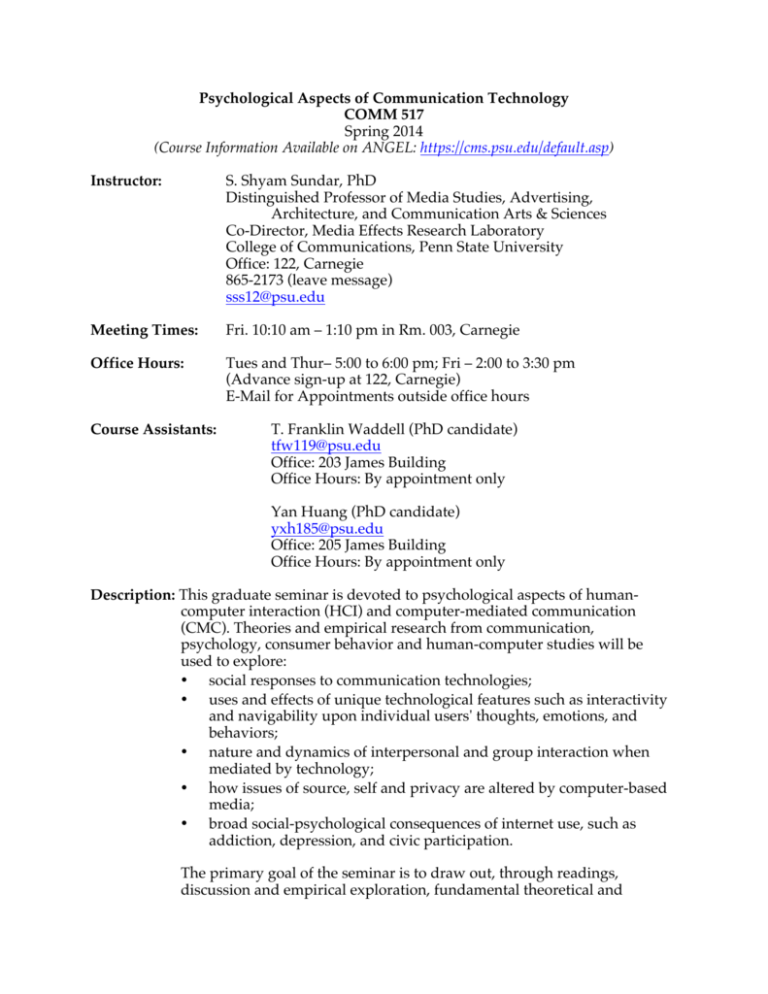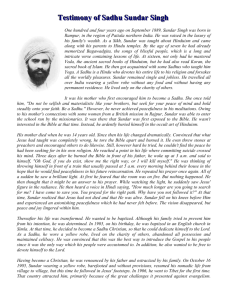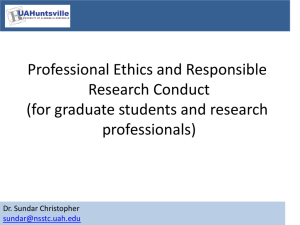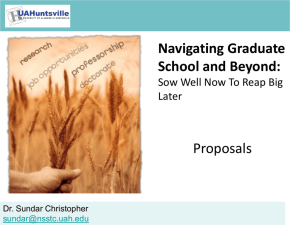Psychological Aspects of Communication Technology COMM 517
advertisement

Psychological Aspects of Communication Technology COMM 517 Spring 2014 (Course Information Available on ANGEL: https://cms.psu.edu/default.asp) Instructor: S. Shyam Sundar, PhD Distinguished Professor of Media Studies, Advertising, Architecture, and Communication Arts & Sciences Co-Director, Media Effects Research Laboratory College of Communications, Penn State University Office: 122, Carnegie 865-2173 (leave message) sss12@psu.edu Meeting Times: Fri. 10:10 am – 1:10 pm in Rm. 003, Carnegie Office Hours: Tues and Thur– 5:00 to 6:00 pm; Fri – 2:00 to 3:30 pm (Advance sign-up at 122, Carnegie) E-Mail for Appointments outside office hours Course Assistants: T. Franklin Waddell (PhD candidate) tfw119@psu.edu Office: 203 James Building Office Hours: By appointment only Yan Huang (PhD candidate) yxh185@psu.edu Office: 205 James Building Office Hours: By appointment only Description: This graduate seminar is devoted to psychological aspects of humancomputer interaction (HCI) and computer-mediated communication (CMC). Theories and empirical research from communication, psychology, consumer behavior and human-computer studies will be used to explore: • social responses to communication technologies; • uses and effects of unique technological features such as interactivity and navigability upon individual users' thoughts, emotions, and behaviors; • nature and dynamics of interpersonal and group interaction when mediated by technology; • how issues of source, self and privacy are altered by computer-based media; • broad social-psychological consequences of internet use, such as addiction, depression, and civic participation. The primary goal of the seminar is to draw out, through readings, discussion and empirical exploration, fundamental theoretical and 2 practical implications of these lines of research for interface design, psychological processing of mediated form and content, human-website interaction, and internet-based mass, group and interpersonal communication. Text and readings: There is no textbook for this class. However, we will be relying heavily on readings for most class meetings. These readings, selected from a wide variety of journals, are available from the Readings folder under the Lessons tab of the class ANGEL space. Assignments and Grading: Class Participation Reading Summary/Critique Discussion Questions One-Pagers Research Project 15% 15% 30% 10% 30% Class Participation: Since the success of this seminar is heavily contingent upon effective participation from all those present, 15 percent of the final grade is devoted to the quality of your class participation. Not only your presence in class, but also your level of preparedness (keeping up with the readings, lectures, etc.) and the caliber of your comments will be included in this score. Reading Summary: Students will take turns presenting summary-cum-critiques of assigned readings. Each student is expected to distribute a 1-2 page handout and make a ten-minute presentation of THREE of the assigned readings in two separate class meetings, followed by questions from the instructor and fellow students. This exercise will count for 15 percent of the final grade in the course, and students going early on in the semester may have the option of bettering their score by electing to summarize/critique a fourth article, subject to availability. Discussion Questions: Every student should e-mail in advance (deadline: 10 am Thursday) at least one question about each of the assigned readings (clearly identify the article on which your question is based, and put all your questions for the week in the body of your email AS WELL AS in a word file attached to that email). That is, if a given class meeting has three articles assigned, each student is required to submit at least three questions prior to that meeting, i.e. one question pertaining to each of the readings. However, if you are presenting a summary/critique of one of those articles, you need not submit a question about that article, but should submit questions relating to the other articles assigned for that class meeting. Class discussions will center on these questions, so try to be open-ended in your queries. Try also to incorporate concepts from other classes and readings outside the class. Discussion questions account for 30% of the grade and will be 3 based on their relevance to the class as well as the level of profound curiosity. A question that is thoughtful as well as thought-provoking will be awarded full points whereas one that perfunctorily seeks factual answers will be awarded minimal points, if at all. In general, successful questions tend to be theoretically rigorous (i.e., frame the question around the “how” and “why” a certain phenomenon occurs), concretize concepts through everyday examples of human interaction with communication technologies, and pose a testable hypothesis for future research. One-Pagers: The goal of this exercise is to encourage creative thinking about technology and technology research. Each student is required to submit a one-page musing (in the form of a story, poem, satire, whatever) about two topics. During most class meetings, the instructor will announce a one-pager topic for the following class. All students are not required to respond to all topics. Just two submissions over the entire semester will do. Grading will be based on the degree of creativity, cleverness and imagination in each of the two submissions. Research Project: Groups of two or three will be formed to facilitate original empirical explorations pertaining to the psychology of communication technology. These groups will conduct a research project, from start to finish, with the objective of making an original contribution to the field. Details will be spelled out later in the semester. Academic Integrity: Academic integrity is the pursuit of scholarly and creative activity in an open, honest and responsible manner, free from fraud and deception, and is an educational objective of the College of Communications and the university. Cheating, including plagiarism, falsification of research data, using the same assignment for more than one class, turning in someone else’s work, or passively allowing others to copy your work, will result in academic penalties at the discretion of the instructor. In serious cases it could also result in suspension or dismissal from the university or in the grade of “XF’ (failed for academic dishonesty) being put on your permanent transcript. As students studying communications, you should understand and avoid plagiarism (presenting the work of others as your own). A discussion of plagiarism, with examples, can be found at http://tlt.psu.edu/plagiarism/student-tutorial/. The rules and policies regarding academic integrity should be reviewed by every student, and can be found online at: www.psu.edu/ufs/policies/47-00.html#49-20, and in the College of Communications document, “Academic Integrity Policy and Procedures.” Any student with a question about academic integrity or plagiarism is strongly encouraged to discuss it with his or her instructor. 4 Note to Students with disabilities: Penn State welcomes students with disabilities into the University's educational programs. If you have a disability-related need for reasonable academic adjustments in this course, contact the Office for Disability Services, ODS located in room 116 Boucke Building at 814-863-1807(V/TTY). For further information regarding ODS, please visit their web site at www.equity.psu.edu/ods/ Instructors should be notified as early in the semester as possible regarding the need for reasonable academic adjustments. Schedule: The schedule includes the main topics for each meeting and the readings required for the meeting. Class discussions will not repeat material in the readings; rather, they will add more depth and attempt to synthesize existing and emergent material with previously established knowledge in the field. (The readings emphasize recency over history and therefore may need context and background by way of additional references—which the instructor will be happy to provide upon request). Each class meeting is tasked with the specific goals of (1) explicating theoretical mechanisms and (2) generating study ideas. It is very important to be on top of the readings in order to participate effectively in class. Topics & Readings Schedule Jan. 17 INTRODUCTION & OVERVIEW Lievrouw, Bucy, Finn, Frindte, Gershon, Haythornthwaite, et al. (2000) Walther, Gay, & Hancock (2005) Bargh & McKenna (2004) Sundar (2009) Jan. 24 RESPONDING SOCIALLY Sundar & Nass (2000) Lee, Peng, Jin, & Yan (2006) Eckles, Wightman, Carlson, Thamrongrattanarit, Bastea-Forte, & Fogg (2009) Jan. 31 USES & USABILITY Valacich, Parboteeah, & Wells (2007) Nardi, Schiano, Gumbrecht, & Swartz (2004) Vasalou, Joinson, & Courvoisier (2010) Tuch, Roth, Hornbæk, Opwis, & Bargas-Avila (2012) Feb. 7 TECHNOLOGY & DEPENDENCY Sheldon, Abad, & Hinsch (2011) Hoffman, Novak, & Venkatesh (2004) Kardefelt-Winther (2014) Tokunaga (2013) 5 Background/Framing/Overview Article: Sundar (2008) Feb. 14 MODALITY AND THE MIND Burgoon, Bonito, Ramirez, Dunbar, Kam, & Fischer (2002) Read, Miller, Appleby, Nwosu, Reynaldo, Lauren, & Putcha (2006) Sundar (2000) Oviatt, Coulston, & Lunsford (2004) Feb. 21 SITUATING AGENCY Bickmore, Pfeifer, & Jack (2009) Stavrositu & Sundar (2012) Lee & Sundar (2013) Fox & Bailenson (2009) Feb. 28 INTERACTING WITH INTERACTIVITY Bucy (2004a) Bucy (2004b) Sundar (2004) Stromer-Galley (2004) Voorveld, Neijens, & Smit (2011) Sundar (2007) Mar. 7 AFFORDING NAVIGATION Mathwick & Rigdon (2004) Pan, Hembrooke, Joachims, Gay, & Granka (2007) Balakrishnan & Sundar (2011) Held, Kimmerle, & Cress (2012) Background/Framing/Overview Articles: Walther (1996); Spears & Lea (1994) Mar. 21 INTERACTING VIRTUALLY Hancock, Thom-Santelli, & Ritchie (2004) Lee (2007) Walther, Van Der Heide, Kim, Westerman, & Tong (2008) Ling, Beenen, Ludford, Wang, Chang, Li, et al. (2005) Mar. 28 INTERACTING UBIQUITOUSLY Waller & Johnston (2009) Ishii (2006) Sparrow, Liu & Wegner (2011) Campbell & Kwak (2011) Apr. 04 TECHNOLOGY & SELF Mesch & Beker (2010) Yee, Bailenson, & Ducheneaut (2009) Sundar & Marathe (2010) Yao & Flanagin (2006) 6 Apr. 11 TECHNOLOGY & CIVIC PARTICIPATION Sunstein (2001) Iyengar (2001) Gil de Zúñiga, Jung, & Valenzuela (2012) Kim (2011) Apr. 18 DATA ANALYSIS Apr. 25 DATA INTERPRETATION May 2 GROUP RESEARCH PROJECT PRESENTATION May 9 GROUP PROJECT REPORT & ABSTRACTS DUE Note: Based on class progress, the instructor reserves the right to amend and change the syllabus, reading schedules, and assignments during the semester. List of Readings in Electronic Reserves (Readings accessible by clicking on the Course Reserves button at http://www.libraries.psu.edu) Balakrishnan, B., & Sundar, S. S. (2011). Where am I? How can I get there? Impact of navigability and narrative transportation on spatial presence. Human Computer Interaction, 26, 161-204. Bargh, J. A., & McKenna, K. Y. A. (2004). The Internet and social life. Annual Review of Psychology, 55, 573-590. Bickmore, T. W., Pfeifer L. M., & Jack, B. W. (2009). Taking the time to care: Empowering low health literacy hospital patients with virtual nurse agents. Proceedings of the 27th International Conference on Human Factors in Computing Systems (ACM SIGCHI), 1265-1274. Bucy, E. P. (2004a). The debate. The Information Society, 20(5), 371. Bucy, E. P. (2004b). Interactivity in society: Locating an elusive concept. The Information Society, 20(5), 373-383. Burgoon, J. K., Bonito, J. A., Ramirez, A., Jr., Dunbar, N. E., Kam, K., & Fischer, J. (2002). Testing the interactivity principle: Effects of mediation, propinquity, and verbal and nonverbal modalities in interpersonal interaction. Journal of Communication, 52(3), 657-677. Campbell, S. W., & Kwak, N. (2011). Mobile communication and civil society: Linking patterns and places of use to engagement with others in public. Human Communication Research, 37(2), 207-222. 7 Eckles, D., Wightman, D., Carlson, C., Thamrongrattanarit, A., Bastea-Forte, M., & Fogg, B. J. (2009). Social responses in mobile messaging: Influence strategies, selfdisclosure, and source orientation. Proceedings of the 27th International Conference on Human Factors in Computing Systems (ACM SIGCHI). 1651-1654. Fox, J., & Bailenson, J. N. (2009). Virtual self-modeling: The effects of vicarious reinforcement and identification on exercise behaviors. Media Psychology, 12, 1-25. Gil de Zúñiga, H., Jung, N., & Valenzuela, S. (2012). Social media use for news and individuals' social capital, civic engagement and political participation. Journal of Computer-Mediated Communication, 17(3), 319-336. Hancock, J. T., Thom-Santelli, J., & Ritchie, T. (2004). Deception and design: The impact of communication technology on lying behavior. Proceedings of the Conference on Human Factors in Computing Systems (CHI’04), 129-134. Held, C., Kimmerle, J., & Cress, U. (2012). Learning by foraging: The impact of individual knowledge and social tags on web navigation processes. Computers in human behavior, 28, 34-40. Hoffman, D. L., Novak, T. P., & Venkatesh, A. (2004). Has the Internet become indispensable? Communications of the ACM, 47(7), 37-42. Ishii, K. (2006). Implications of mobility: The uses of personal communication media in everyday life. Journal of Communication, 56(2), 346-365. Iyengar, S. (2001). Cynicism and choice: A response to The Daily We. Boston Review. Retrieved from http://www.bostonreview.net/BR26.3/iyengar.html. Kardefelt-Winther, D. (2014). Problematizing excessive online gaming and its psychological predictors. Computers in Human Behavior, 31, 118-122. Kim, Y. (2011). The contribution of social network sites to exposure to political difference: The relationships among SNSs, online political messaging, and exposure to cross-cutting perspectives. Computers in Human Behavior, 27(2), 971977. Lee, E. -J. (2007). Effects of gendered language on gender stereotyping in computer mediated communication: The moderating role of depersonalization and genderrole orientation. Human Communication Research, 33(4), 515-535. Lee, K. M., Peng, W., Jin, S., & Yan, C. (2006). Can robots manifest personality?: An empirical test of personality recognition, social responses, and social presence in human-robot interaction. Journal of Communication, 56(4), 754-772. Lee, J. Y., & Sundar, S. S. (2013). To tweet or to retweet? That is the question for health professionals on Twitter. Health Communication, 28 (5), 509-524. Lievrouw, L.A., Bucy, E.P., Finn, T.A., Frindte, W., Gershon, R.A., Haythornthwaite, C., 8 Köhler, T., Metz, J. M., & Sundar, S. S. (2000). Bridging the subdisciplines: An overview of communication and technology research. Communication Yearbook, 24, 271-295. Ling, K., Beenen, G., Ludford, P., Wang, X., Chang, K., Li, X., et al. (2005). Using social psychology to motivate contributions to online communities. Journal of ComputerMediated Communication, 10(4), article 10. Retrieved from http://jcmc.indiana.edu/vol10/issue4/ling.html Mathwick, C., & Rigdon, E. (2004). Play, flow, and the online search experience. Journal of Consumer Research, 31(2), 324-332. Mesch, G. S., & Beker, G. (2010). Are norms of disclosure of online and offline personal information associated with the disclosure of personal information online? Human Communication Research, 36(4), 570-592. Nardi, B. A., Schiano, D. J., Gumbrecht, M., & Swartz, L. (2004). Why we blog. Communications of the ACM, 47(12), 41-46. Oviatt, S., Coulston, R., & Lunsford, R. (2004). When do we interact multimodally?: Cognitive load and multimodal communication patterns. Proceedings of the 6th International Conference on Multimodal Interfaces (ACM), 129–136. Pan, B., Hembrooke, H., Joachims, T., Lorigo, L., Gay, G., & Granka, L. (2007). In Google we trust: Users' decisions on rank, position, and relevance. Journal of ComputerMediated Communication, 12(3), 801-823. Read, S. J., Miller, L. C., Appleby, P. R., Nwosu, M. E., Reynaldo, S., Lauren, A., & Putcha, A. (2005). Socially optimized learning in a virtual environment: Reducing risky sexual behavior among men who have sex with men. Human Communication Research, 32(1), 1-34. Sheldon, K. M., Abad, N., & Hinsch, C. (2011). A two-process view of Facebook use and relatedness need-satisfaction: Disconnection drives use, and connection rewards it. Journal of Personality and Social Psychology, 100(4), 766-775. Sparrow, B., Liu, J., & Wegner, D. M. (2011). Google effects on memory: Cognitive consequences of having information at our fingertips. Science, 333, 776-778. Spears, R., & Lea, M. (1994). Panacea or Panopticon? The hidden power in computermediated communication. Communication Research, 21(4), 427-459. Stavrositu, C., & Sundar, S. S. (2012). Does blogging empower women? Exploring the role of agency and community. Journal of Computer-Mediated Communication, 17(4), 369-386. Stromer-Galley, J. (2004). Interactivity-as-product and interactivity-as-process. The Information Society, 20, 391-394. 9 Sundar, S. S. (2000). Multimedia effects on processing and perception of online news: A study of picture, audio, and video downloads. Journalism & Mass Communication Quarterly, 77(3), 480-499. Sundar, S. S. (2004). Theorizing interactivity’s effects. The Information Society, 20, 385-389. Sundar, S. S. (2007). Social psychology of interactivity in human-website interaction. In A. N. Joinson, K. Y. A. McKenna, T. Postmes & U-D. Reips (Eds.), The Oxford handbook of internet psychology (pp. 89-104). Oxford, UK: Oxford University Press. Sundar, S. S. (2008). The MAIN model: A heuristic approach to understanding technology effects on credibility. In M. J. Metzger & A. J. Flanagin (Eds.), Digital media, youth, and credibility (pp. 72-100). Cambridge, MA: The MIT Press. Sundar, S. S. (2009). Media effects 2.0: Social and psychological effects of communication technologies. In R. L. Nabi & M. B. Oliver (Eds.), The SAGE handbook of media processes and effects (pp. 545-560). Thousand Oaks, CA: Sage Publications. Sundar, S. S., & Marathe, S. S. (2010). Personalization vs. customization: The importance of agency, privacy and power usage. Human Communication Research, 36, 298-322. Sundar, S. S., & Nass, C. (2000). Source orientation in human-computer interaction. Communication Research, 27(6), 683-703. Sunstein, C. R. (2001). The daily we: Is the internet really a blessing for democracy? Boston Review. Retrieved from http://bostonreview.net/BR26.3/sunstein.html Tokunaga, R. S. (2013), Engagement with novel virtual environments: The role of perceived novelty and flow in the development of the deficient self-regulation of Internet use and media habits. Human Communication Research, 39(3), 365–393. Tuch, A. N., Roth, S. P., Hornbæk, K., Opwis, K., & Bargas-Avila, J. A. (2012). Is beautiful really usable? Toward understanding the relation between usability, aesthetics, and affect in HCI. Computers in Human Behavior, 28(5), 1596-1607. Valacich, J. S., Parboteeah, D. V., & Wells, J. D. (2007). The online consumer’s hierarchy of needs. Communications of the ACM, 50(9), 84-90. Vasalou, A., Joinson, A. N., & Courvoisier, D. (2010). Cultural differences, experience with social networks and the nature of “true commitment” in Facebook. International Journal of Human-Computer Studies, 68(10), 719-728. Voorveld, H. A. M., Neijens, P. C., & Smit, E. G. (2011). The relation between actual and perceived interactivity What makes the web sites of top global brands truly interactive? Journal of Advertising, 40(2), 77-92. Waller, V., & Johnston, R. B. (2009). Making ubiquitous computing available. Communication of the ACM, 52(10), 127-130. 10 Walther, J. B. (1996). Computer-mediated communication: Impersonal, interpersonal and hyperpersonal interaction. Communication Research, 23(1), 3-43. Walther, J. B., Gay, G., & Hancock, J. T. (2005). How do communication and technology researchers study the internet? Journal of Communication, 55(3), 632-657. Walther, J. B., Van Der Heide, B., Kim, S. –Y., Westerman, D., & Tong, S. T. (2008). The role of friends‘ appearance and behavior and evaluations of individuals on Facebook: Are we known by the company we keep? Human Communication Research, 34(1), 28-49. Yao, M. Z., & Flanagin, A. J. (2006). A self-awareness approach to computer-mediated communication. Computers in Human Behavior, 22(3), 518-544. Yee, N., Bailenson, J.N., & Ducheneaut, N. (2009). The proteus effect: Implications of transformed digital self-representation on online and offline behavior. Communication Research, 36(2), 285-312.










